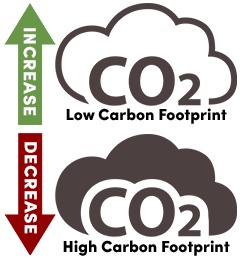Carbon Footprint of Food
A carbon footprint is the total amount of greenhouse gas emissions that are generated by a person, organization, product, or event. It is measured in units of carbon dioxide equivalents (CO2e). Food production, processing, transportation, and storage contribute significantly to greenhouse gas emissions. Therefore, the carbon footprint of food refers to the emissions produced throughout the life cycle of a food product, from the production of raw materials to the disposal of food waste. Factors that contribute to the carbon footprint of food include the type of food, the location of production, the type of farming or production practices used, the mode of transportation, and the packaging used. By understanding the carbon footprint of food, individuals and organizations can make more informed choices about what they eat and how they produce and consume food in a more sustainable way.
Making our Impact on the World, Not the Planet
Campus Dining has partnered with UB Sustainability to highlight the carbon impact of dining options because students have expressed that the climate crisis informs their decision making and want to reduce their carbon footprint. Since global food production accounts for nearly 1/3 of all greenhouse gas emissions, switching to low-carbon dining is a highly impactful way to reduce greenhouse gas emissions and mitigate climate change.
Low-carbon dining refers to making food choices that have low greenhouse gas emissions associated with their life cycle. Some examples of low-carbon foods are: nuts, soy products, local vegetables, and dairy alternatives. Some food on the high end of carbon impact are: beef, lamb, cheese, chocolate, and coffee.
Phases of this Initiative
Phase 1 - Plant Powered Mondays in April 2023
On each Monday during the month, guests will find a more plant-powered and decreased meat menu beyond the Strictly Vegetarian section at Crossroads Culinary Center (C3). The dining center will highlight the diverse plant protein options as well as the alternative options that are now widely available. The purpose of the initiative is to encourage students to look at the environmental cost of meat but not to forbid it.
Phase 2 - The launch of Menu Identifiers
This new system makes it easier to consider the carbon impact of the food in the dining center and find routine ways to reduce the carbon footprint of your food choices. We do not expect every student to completely change what they eat, just have the information they need to reduce their carbon footprint with the food they are choosing every day. Small changes can make a big difference.

Low Carbon Footprint
0 - .29 kg CO2

Moderate Carbon Footprint
.3 - .59 kg CO2

High Carbon Footprint
.6 - 1+ kg CO2
Methodology behind the Grading Icons
To calculate the carbon footprint of the dishes served at UB, we considered the carbon emissions associated with each ingredient that goes into a recipe. We utilized scientific carbon emissions calculated by MyEmissions. They have created a comprehensive, open-source database of emissions for ingredients by performing life cycle analysis from cradle to store.
Together with the list of ingredients and quantities in each recipe, the total carbon footprint associated with each dish was calculated. After analyzing the data, we established criteria to categorize emissions into high, medium, and low thresholds.
Minimize Your Carbon Footprint
The UB community can utilize this tool to identify the carbon footprint of the dishes around campus and make more sustainable choices when it comes to food. Choosing more foods with low carbon footprint and fewer foods with a high carbon footprint can greatly decrease the institution’s carbon footprint. Let's all be change agents and create a better future!







